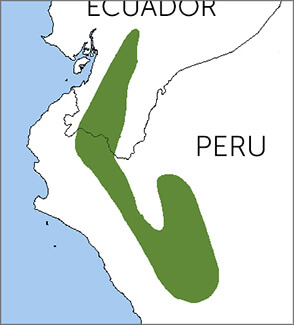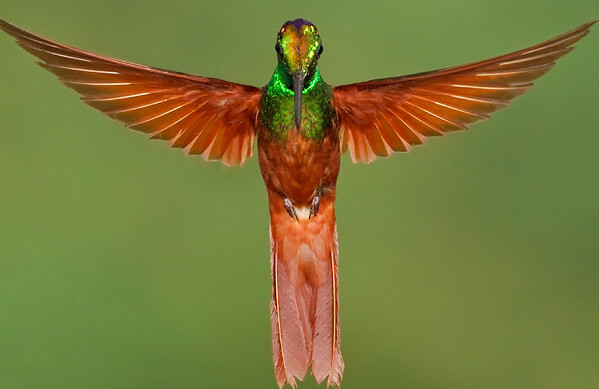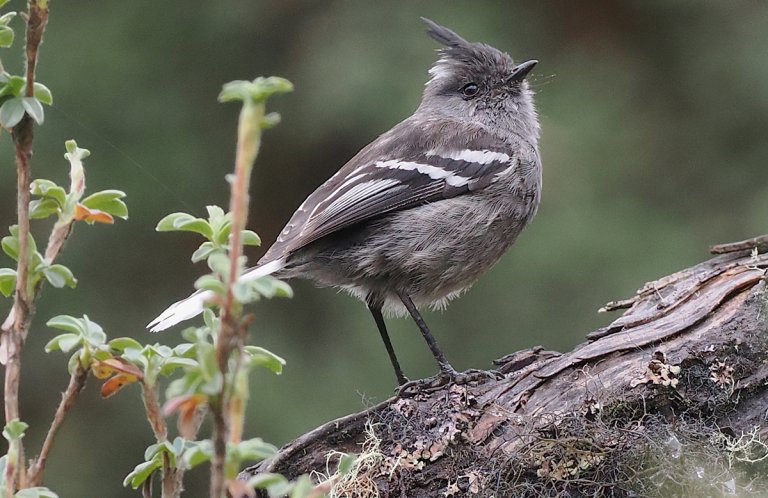 Like other hummingbirds of the genus Coeligena, including the Glittering Starfrontlet, the Rainbow Starfrontlet is a bird of mountain forests and edges. It's one of the larger hummingbird species found in the Andes and is mostly chestnut-colored with a green hood. The bird's glittering, rainbow-colored forehead varies in color according to subspecies, often showing an iridescent spectrum of green, yellow, orange, red, and blue.
Like other hummingbirds of the genus Coeligena, including the Glittering Starfrontlet, the Rainbow Starfrontlet is a bird of mountain forests and edges. It's one of the larger hummingbird species found in the Andes and is mostly chestnut-colored with a green hood. The bird's glittering, rainbow-colored forehead varies in color according to subspecies, often showing an iridescent spectrum of green, yellow, orange, red, and blue.
Rainbow Starfrontlets range from southern Ecuador to northern Peru. They can be seen in several Ecuadorian reserves where ABC works with in-country partner Fundación Jocotoco. This species is most threatened by habitat loss caused by logging, mining, and human settlement.
Sign up for ABC's eNews to learn how you can help protect birds
Insect Hunter
Rainbow Starfrontlets can be seen foraging low to the ground along the edges of forests and adjacent shrubby areas. Like the Rufous Hummingbird and other hummingbirds, they often employ “traplining,” a feeding strategy in which the bird visits nectar sources in a regular, repeated sequence.
Rainbow Starfrontlets also take small insects by picking them off leaves or branches, or by snatching spiders off their webs—a habit consistent with other hummingbird species. A nesting female, which needs the protein provided by insects to successfully raise her young, may capture up to 2,000 insects in a day.

Rainbow Starfrontlet by Luke Seitz
Territory with Benefits
Male starfrontlets establish feeding territories and aggressively chase away other males—as well as large insects—with intimidating displays, flying high above the forest canopy while calling in a high-pitched chatter. Males court visiting females by flying in a U-shaped pattern. One male may mate with several females but is otherwise uninvolved in raising the young.
The female Rainbow Starfrontlet builds a cup-shaped nest of plant fibers, lichens, and spider webs on a low, thin horizontal branch where she lays an average of two eggs. The chicks grow quickly and leave the nest at about 7 to 10 days old.
Seeing Starfrontlets
Although the Rainbow Starfrontlet is considered a fairly common species, it occurs in a very restricted range, which makes it especially vulnerable to habitat changes or loss. The species is split into six subspecies, found in a variety of humid and dry forests. Each subspecies varies slightly in colors on its nape and crown.
One of the best places to see the Rainbow Starfrontlet is the Utuana Reserve, managed by Fundación Jocotoco, where the birds visit feeders daily. A visit to Utuana can be combined into a birding route with the Yunguilla, Buenaventura, and Tapichalaca Reserves, which protect other interesting and endangered species such as Pale-headed Brush Finch, Long-wattled Umbrellabird, and Jocotoco Antpitta.
Support ABC's conservation work for hummingbirds and other birds throughout the Americas! Donate today.



















































